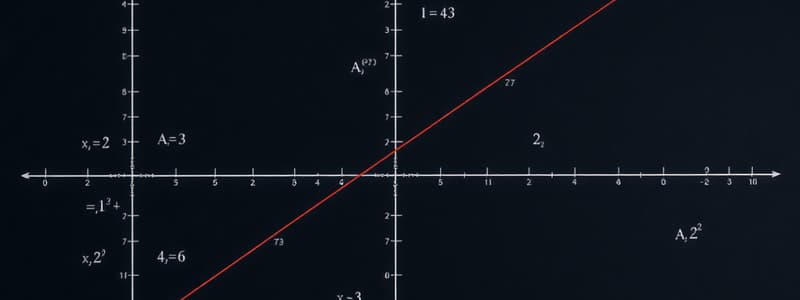Podcast
Questions and Answers
Which equation represents a line with a slope of -4 that passes through the point (0, 2)?
Which equation represents a line with a slope of -4 that passes through the point (0, 2)?
- $y = 4x + 2$
- $y = 4x - 2$
- $y = -4x - 2$
- $y = -4x + 2$ (correct)
Determine the equation of a line passing through the points (-3, 4) and (5, -2).
Determine the equation of a line passing through the points (-3, 4) and (5, -2).
$y = -\frac{3}{4}x + \frac{7}{4}$
Simplify the expression $(5a^2b^5)^3$, ensuring all exponents are positive.
Simplify the expression $(5a^2b^5)^3$, ensuring all exponents are positive.
- $5a^6b^{15}$
- $5a^5b^8$
- $125a^6b^{15}$ (correct)
- $125a^5b^8$
When converting 0.000000002 meters to scientific notation, the result is $2 \times 10^{-9}$ meters.
When converting 0.000000002 meters to scientific notation, the result is $2 \times 10^{-9}$ meters.
To express a value of $4.3 \times 10^7$ in standard form, move the decimal point 7 places to the ____ .
To express a value of $4.3 \times 10^7$ in standard form, move the decimal point 7 places to the ____ .
Evaluate the polynomial expression $(3x^2 - 8x + 14) + (7x^2 + 3x - 2)$.
Evaluate the polynomial expression $(3x^2 - 8x + 14) + (7x^2 + 3x - 2)$.
Determine the product of the polynomials $(2x + 5)(3x - 6)$.
Determine the product of the polynomials $(2x + 5)(3x - 6)$.
Match the exponential expression simplification with the appropriate power rule.
Match the exponential expression simplification with the appropriate power rule.
Flashcards
Slope-Intercept Form
Slope-Intercept Form
A straight line on a graph represented by y = mx + b, where 'm' is the slope and 'b' is the y-intercept.
Horizontal Line
Horizontal Line
A line with a slope of zero. It's equation is in the form y = constant.
Vertical Line
Vertical Line
A line with an undefined slope. Its equation is in the form x = constant.
Vertical Intercept
Vertical Intercept
Signup and view all the flashcards
Scientific Notation
Scientific Notation
Signup and view all the flashcards
Exponent
Exponent
Signup and view all the flashcards
Simplify
Simplify
Signup and view all the flashcards
Distributive Property
Distributive Property
Signup and view all the flashcards
Study Notes
- These notes cover graphing lines, finding equations of lines, working with exponents and polynomials, converting to scientific notation, and factoring polynomials
Review of Lines
- To graph y = -x + 2, locate the y-intercept at (0, 2), then use the slope of -1/3 to find additional points and draw the line
- To graph a line with slope m = 1/2 passing through (1, 2), plot the point (1, 2) and use the slope to find another point, then draw a line through them
- The equation y = -2 represents a horizontal line that intersects the y-axis at -2
- The equation x = 6 represents a vertical line that intersects the x-axis at 6
- To find the equation of the line with a slope of 1/2 passing through the point (1,2), use the point-slope form of a line
- To find the equation of the line passing through (-3, 4) and (5, -2), first calculate the slope and then use the point-slope form with either point
Interpreting Graphs of Lines
- The vertical intercept of a credit card debt graph represents the initial amount of debt at the beginning of the year
- The horizontal intercept represents the time when the debt is fully paid off
Exponents and Polynomials
- To simplify (-4x²y⁷)(7xy²), multiply the coefficients and add the exponents of like variables: -28x³y⁹
- To simplify (5a²b⁵)³, raise each factor inside the parentheses to the power of 3: 125a⁶b¹⁵
- To simplify (6x²y²)²(-5x²y)⁴, apply the power to power rule and then multiply the terms: 36x⁴y⁴ * 625x⁸y⁴ = 22500x¹²y⁸
- To simplify c⁴d⁻⁵ / c⁻²d³, subtract the exponents of like variables: c⁶d⁻⁸ = c⁶/d⁸
Scientific Notation Conversions
- 52,600,000,000 in scientific notation: 5.26 x 10¹⁰
- 0.000,000,002 in scientific notation: 2 x 10⁻⁹
- 4.3 x 10⁷ in standard form: 43,000,000
- 6.024 × 10⁻⁶ in standard form: 0.000006024
Operations in Scientific Notation
- -30(45.7 × 10⁻⁸) = -1371 x 10⁻⁸ = -1.371 x 10⁻⁵
- (1.5×10⁻¹²) / (3.0×10⁸) = 0.5 x 10⁻²⁰ = 5 x 10⁻²¹
Polynomial Operations
- (3x² - 8x + 14) + (7x² + 3x – 2) = 10x² - 5x + 12
- (5x² − 8x + 2) – (2x² – 8) = 3x² - 8x + 10
- 5x(7x + 8) = 35x² + 40x
- -8x(7x² + 2x - 4) = -56x³ - 16x² + 32x
- (2x + 5)(3x - 6) = 6x² + 3x - 30
- (3x + 7)² = 9x² + 42x + 49
- (x - 4)(x² + 5x − 3) = x³ + x² - 23x + 12
Factoring Polynomials
- 24x³ - 32x² = 8x²(3x - 4)
- 2y(x + 3) – 5(x + 3) = (2y - 5)(x + 3)
- 5m² + 10m – 7m – 14 = 5m(m + 2) - 7(m + 2) = (5m - 7)(m + 2)
- x² + 16x + 64 = (x + 8)(x + 8) = (x + 8)²
- x² - 4x - 21 = (x - 7)(x + 3)
- 2x² + 13x + 15 = (2x + 3)(x + 5)
- x² - 64 = (x + 8)(x - 8)
- x² + x + 3 is prime
- g³ - 8g² + 15g = g(g² - 8g + 15) = g(g - 3)(g - 5)
- 4xyz + 2xz - 24yz – 12z = 2z(2xy + x - 12y - 6) = 2z[x(2y + 1) - 6(2y + 1)] = 2z(x - 6)(2y + 1)
Studying That Suits You
Use AI to generate personalized quizzes and flashcards to suit your learning preferences.




